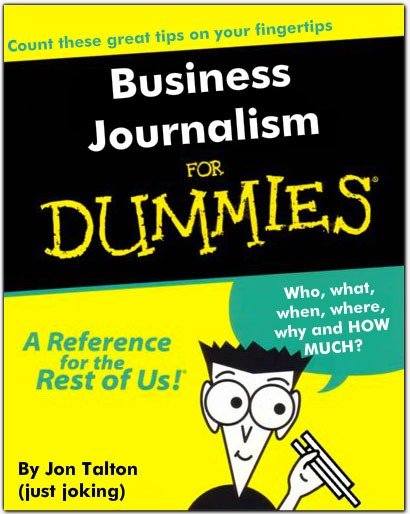In the previous Business Journalism for Dummies post, I laid out some of the basics you need to know if you’re starting out or moving over to business news from metro or features. Now let’s move on to some macro concepts that should inform much of your coverage, even if you’re on the small-business beat.
Shareholders rule.
Since the 1980s, the so-called shareholders’ rights movement has fundamentally changed the way public companies operate. For decades before that, people and institutions owned stock for the long haul, making money off dividends. Since then, everything is about keeping the stock price rising. “Owners” move in and out of individual stocks more frequently and expect to see most of their gains from those increased prices.
As a result, the corporate focus is on the short term, not only the next quarter but the next day’s closing price. Companies are under pressure to merge to either increase their market share and eliminate competitors or, if in the target firm, accept the deal and let shareholders pocket the quick payoff. Lax antitrust enforcement has abetted the game.
The result is that fewer cities have hometown headquarters. Industries are more concentrated (think banking, broadcasting, airlines). Top executives’ pay is tied to a rising stock price. Cutting jobs and research and development may be suicidal in the long haul, but they help cut costs in the short-term and that’s the horizon. A company that fails to play by these rules must be very profitable or unique (such as Amazon.com) or it will be targeted by activist investors that want to put it on the block.
Globalization.
The world economy is more closely connected than any time since 1914, on the edge of World War I. What happens in Asia, Europe or, in the case of oil, the Middle East, affects even small businesses. Customers are at the end of a 10,000-mile supply chain. With a surplus of labor, the world offers companies the chance to send jobs and entire industries offshore.
Trade.
Even midsized companies, and an increasing number of small ones, are engaged in trying to sell goods and services overseas. They face competitors that encounter few if any trade barriers to selling in America, the world’s most affluent large market. On the other hand, they can confront a host of overt or stealth protectionism in overseas markets. Either way, with the United States as a mature market, more companies look overseas for growth. America runs a huge trade deficit — we buy more from the world than we sell it — and this translates into millions of lost jobs at home. At the same time, trade liberalization ensures plenty of cheap stuff for American “consumers.”
China.
It has in a relatively short time overtaken Japan to become the world’s second-largest economy in terms of gross domestic product. China is highly complex, so few sweeping statements can be made without numerous qualifiers. The country’s size makes its moves consequentially worldwide. In the 19th century, Napoleon said, “Let her sleep, for when she wakes she will shake the world.” China is now fully awake.

China has become the world’s largest manufacturer and trading nation, displacing the United States from decades in that position. It also has huge problems: the Communist Party’s attempt to hold power; the need to provide jobs to ensure social peace; an aging and increasingly costly workforce; pollution, and the danger of a slowdown and even credit collapse that would shake the world.
Regulation.
Many businesses and industries face regulation from all levels of government and complain about it constantly. Yet they also spend huge sums of shareholders’ money to “capture” regulators (and the courts) to look the other way, accept risky practices as safe or otherwise be lapdogs. They fund PR shops, “think tanks” and academics to peddle the notion that free markets are self-policing and regulation only costs jobs. This dogma and lack of regulatory rigor were behind the costly scandals of 2001 (Enron, etc.) and especially the practices that caused the Great Recession. At the same time, relations between government and big business are cozy, with many corporations enjoying enormous subsidies and tax breaks. Make sure you report on them.
Jobs.
Since the turn of the century, the great American jobs machine has been failing. Even now, nearly five years after the end of the Great Recession, nearly 10 million are officially unemployed and many more are under-employed. For example, millions are stuck in part-time work or the “gig economy” when they want full-time jobs. The reasons are complex — the biggest is the huge demand hole of the recession — but the consequences far-reaching. With corporations showing no inclination to substantially increase hiring and advanced automation risking more jobs, things won’t get better anytime soon. The problem manifests itself one way or the other in nearly any story you cover.
Inequality.
Thanks to the near-death of unions, decades of tax cuts and legal tax evasion for the rich and corporations, the loss of good manufacturing jobs, globalization and technology, America is more unequal now than any time since the Gilded Age. This is not a meme of “liberals” but an economic reality. It makes it more difficult for average people to start a business or get ahead. It is cutting into the sales of Wal-Mart and the dollar stores. Combined with the jobs crisis, inequality is the most profound issue facing the country.
Energy.
I’ve tried to stay away from the high specialties of business journalism, but this is one you’ll need at least a basic grounding in. The global economy runs on fossil fuels and their cost and availability affects everything. When oil prices are above $100 a barrel, they become a drag on growth. Fossil fuels enjoy big subsidies and other breaks from Washington. At the same time, they help cause climate change which brings huge costs. Fracking produces vast environmental damage and a highly explosive oil; tar sands are an environmental nightmare and costly to refine.
Be skeptical of any claims about unlimited supplies of cheap oil. Those days are gone. The only reason fracking plays can raise capital is because oil is relatively expensive.
Alternative, renewable or “green” energy is often oversold. So don’t be a chump. The biggest issue is how much fossil fuels it requires to make the alt energy, an equation known as energy in/energy out (EIEO). Many alternatives require as much or even more energy inputs than they energy they ultimately produce. Hydropower, as seen in the Pacific Northwest, is an alternative with a good EIEO. Some solar may be. Many other schemes are not.
Energy costs are a huge part of any businesses calculus. A fuel spike can send the airline industry into bankruptcy. Fossil fuel feed stocks make all sorts of products from plastics to fertilizer. So know that energy is part of your beat, no matter which beat you cover.
Finance.
The American economy’s biggest element is no longer making things. It is “financial services.” Covering banking is another post, but here are some basics. Banking was once boring: taking in deposits and lending them out at a higher interest rate to productive, job-creating enterprises. Now much of the sector is gambling that does little to create jobs and kills many. When it melts down, it can take the entire economy with it, as almost happened in 2008-09.
Finance is more than banks. It includes the shadow banking industry, private equity, hedge funds, venture capital and angel investors. More broadly, it is part of the FIRE (finance, insurance and real estate) sector.
Big companies can raise capital easily and do so through a variety of complex means, from selling bonds to floating securities in the overnight markets. Since the recession, it has been harder for small companies to get bank loans or other financing.
You will run into private equity outfits that buy a local company. There are two types: Ones that “strip and flip,” cutting jobs, spinning off or closing “underperforming” business lines, and reselling the company or taking it public again. This is often a trauma for localities. When the playerz take on too much debt, they often saddle the company with a burden that ensures it ends in bankruptcy court (but they got their profits and fees up front). The other consists of more patient and less destructive investors.
As you realize, business is no place for dummies. But armed with these primers and a hunger to keep learning, you are in the sexiest assignment in journalism. Bon chance.










